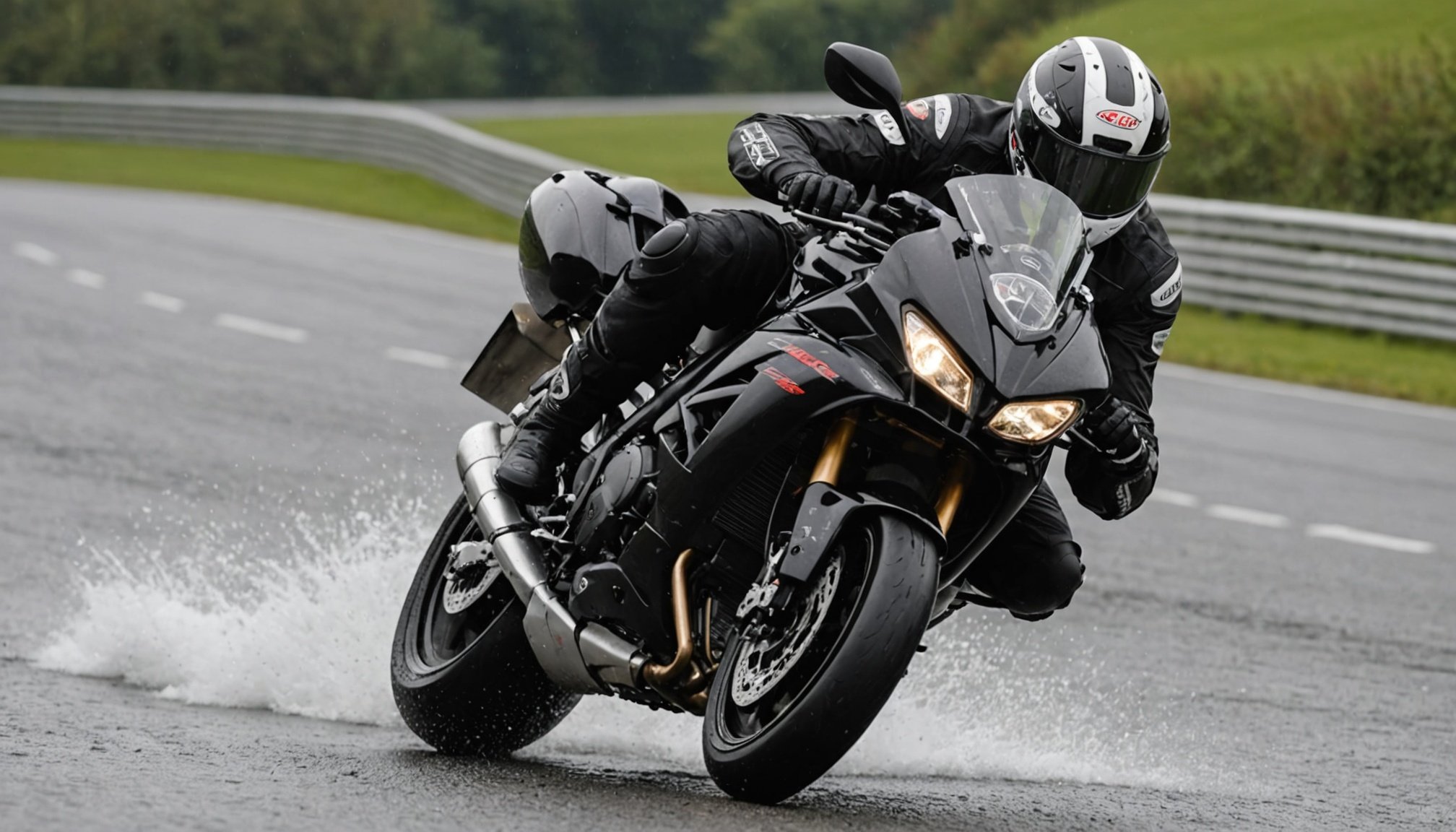Unveiling How Different Sport Bike Tires Influence Handling in the UK’s Wet Weather
When it comes to riding a bike in the UK, one of the most critical factors to consider is the tire you choose, especially in the country’s notoriously wet and unpredictable weather. The right tire can make all the difference between a safe, enjoyable ride and a hazardous one. Here, we’ll delve into how different sport bike tires impact handling in wet conditions, providing you with the insights you need to make an informed decision.
Understanding Tire Tread and Its Impact on Wet Weather Handling
The tread pattern of a tire is perhaps the most crucial aspect when it comes to handling in wet weather. A good tread design can significantly enhance grip, reduce the risk of skidding, and improve overall stability.
This might interest you : Mastering the guidelines: a comprehensive guide to uk laws for riding sport bikes in bus lanes
Tread Pattern and Depth
Tires designed for wet conditions typically feature a more aggressive tread pattern with deeper tread depth. For example, the Vittoria Terreno Wet G2.0 has a highly aggressive tread pattern with widely spaced, siped knobs. This design allows for excellent grip in both sloppy and claggy mud, and the tire sheds dirt easily, reducing the risk of mud build-up on the bike frame[1].
In contrast, tires like the Continental GP5000 AS TR, designed for all-season use, feature a thicker tread and a grippier rubber compound. These tires are optimized for wet and cold weather conditions, providing a balance between grip and rolling resistance[3].
Also to see : Unlock superior traction on uk’s bumpy roads: a complete guide to optimizing your sport bike”s rear suspension
Real-World Examples
-
Vittoria Terreno Wet G2.0: This tire is a standout for UK winter conditions. Its aggressive tread pattern and puncture-resistant TNT casing make it ideal for riding in wet and muddy terrain. Despite its focus on wet conditions, it also performs well in other weather, although it may feel slightly draggy on the road[1].
-
WTB Raddler TCS Light: Designed to handle tougher terrain, the Raddler features deeper central lugs and similar side lugs to the WTB Riddler. This tire excels in both wet and dry conditions, handling everything from rocks and roots to ice and snow without significant drag[1].
The Role of Tire Size and Width in Wet Weather
Tire size and width are also critical factors in how a bike handles in wet weather. Wider tires generally offer better traction and comfort but can affect the overall performance of the bike.
Benefits of Wider Tires
-
Increased Traction: Wider tires provide a larger contact patch with the road, which can significantly improve grip in wet conditions. For instance, the WTB Sendero, with its Road Plus 650 x 47 format, offers high-volume comfort and large-diameter efficiency, making it ideal for gravel riding in wet weather[5].
-
Comfort and Stability: Wider tires can run at lower pressures, which enhances comfort and stability. The Specialized S-Works Mondo, available in widths up to 35mm, allows for a comfortable ride and better handling on rough surfaces[3].
Practical Considerations
When choosing a tire size, it’s essential to consider the compatibility with your bike frame and the type of riding you will be doing. Here are some practical tips:
- Check Frame Clearance: Ensure that the wider tire fits within your bike frame’s clearance. This is particularly important for road bikes, which may have limited space for wider tires.
- Adjust Tire Pressure: Running lower tire pressures can improve traction but requires careful adjustment to avoid pinch flats. Refer to the Enve Tyre Pressure Chart for guidance on the right pressure for your weight and wheel setup[3].
Puncture Protection and Its Impact on Riding Confidence
Puncture protection is another vital aspect to consider, especially in wet weather where road debris can be more hazardous.
Tubeless vs. Traditional Tires
Tubeless tires have become increasingly popular due to their enhanced puncture protection. The Schwalbe Pro One TLE, for example, features Schwalbe’s Addix compound and Souplesse casing, which offer decreased rolling resistance and increased comfort. The tubeless setup also provides better puncture protection, as the sealant can plug small punctures, allowing you to continue riding with minimal disruption[3].
Real-World Benefits
-
WTB Sendero: This tire features WTB’s TCS (Tubeless Compatible System) and SG2 puncture protection technology, providing bead-to-bead coverage to protect against slashes and punctures. This makes it an excellent choice for riders who need high performance and reliability in wet conditions[5].
-
Continental GP5000 AS TR: This tire includes a thicker tread and sidewalls along with a reformulated rubber compound for increased wet and cold weather grip. It also features a Vectran breaker for puncture protection, making it a reliable option for all-season riding[3].
Rolling Resistance and Its Effect on Performance
Rolling resistance is a key factor in how efficiently a tire performs, especially in wet weather where energy conservation is crucial.
Balancing Grip and Rolling Resistance
Tires that excel in wet conditions often have a trade-off in terms of rolling resistance. For instance, the Vittoria Terreno Wet G2.0, while excellent in mud, is slightly draggy on the road. However, tires like the Continental GP5000 AS TR manage to balance grip and rolling resistance effectively, making them suitable for a wide range of conditions[1][3].
Real-World Comparisons
Here’s a comparison of some top tires in terms of their rolling resistance and wet weather performance:
| Tire Model | Rolling Resistance | Wet Weather Performance | Puncture Protection |
|---|---|---|---|
| Vittoria Terreno Wet G2.0 | Medium-High | Excellent | High |
| Continental GP5000 AS TR | Medium | Very Good | High |
| WTB Raddler TCS Light | Medium | Excellent | High |
| Schwalbe Pro One TLE | Low-Medium | Very Good | High |
| Specialized S-Works Mondo | Medium | Very Good | High |
Dry Handling and Transitioning Between Conditions
While wet weather handling is crucial, it’s also important to consider how tires perform in dry conditions and how they transition between different weather states.
Tires for Mixed Conditions
Tires like the Halo GXC are designed to be solid all-around performers. They offer a decent tread pattern that provides grip on many surfaces without sacrificing rolling speed. These tires are ideal for riders who encounter a mix of wet and dry conditions during their rides[1].
Real-World Transition
- Vittoria Terreno Dry: Although billed as a dry, hardpack tire, the Terreno Dry performs well in all but the worst conditions. It serves up a surprising amount of grip even over wet roots, making it a versatile option for mixed terrain riding[1].
Practical Tips for Choosing the Best Tire for Wet Weather
Choosing the right tire for wet weather riding involves several considerations. Here are some practical tips to help you make the best decision:
Assess Your Riding Style
- Gravel Riding: If you frequently ride on gravel or mixed terrain, look for tires with aggressive tread patterns and high puncture protection, like the WTB Raddler or Vittoria Terreno Wet G2.0.
- Road Bike: For road bikes, consider tires with a balance between grip and rolling resistance, such as the Continental GP5000 AS TR or Schwalbe Pro One TLE.
Check Tire Pressure
- Lower Pressures: Running lower tire pressures can enhance traction and comfort. Use resources like the Enve Tyre Pressure Chart to find the optimal pressure for your weight and wheel setup.
Consider Tubeless Options
- Tubeless Benefits: Tubeless tires offer better puncture protection and can run at lower pressures. If you’re new to tubeless, consider the ease of setup and the availability of sealant.
Choosing the right sport bike tire for riding in the UK’s wet weather is a critical decision that can significantly impact your safety and enjoyment. By understanding the importance of tread pattern, tire size, puncture protection, and rolling resistance, you can select a tire that meets your needs.
As Vittoria notes, “The Terreno Wet has the most aggressive tread pattern, making it a great option for UK winter conditions.” Similarly, Continental emphasizes the importance of a grippier rubber compound in their GP5000 AS TR, stating it “increases wet/cold weather grip”[1][3].
In the end, the best tire for you will depend on your specific riding style, the terrain you encounter, and your personal preferences. By considering these factors and choosing a tire that balances performance, grip, and puncture protection, you can ensure a safe and enjoyable ride, no matter the weather.
Future High-Performance Tires: What to Expect
As technology continues to evolve, we can expect even more advanced tires that combine high performance with enhanced safety features.
Innovations in Materials and Design
- New Compounds: Future tires are likely to feature new rubber compounds that offer better grip in wet conditions without compromising rolling resistance.
- Advanced Casing: Innovations in tire casing, such as lighter and more durable materials, will continue to improve puncture protection and overall performance.
Integration with Other Technologies
- Smart Tires: The integration of smart technologies, such as sensors to monitor tire pressure and condition, could become more prevalent, enhancing safety and performance.
In conclusion, the right tire can transform your riding experience, especially in the challenging wet weather conditions of the UK. By understanding the nuances of different tire designs and technologies, you can make an informed choice that ensures your safety and enjoyment on the road.
















